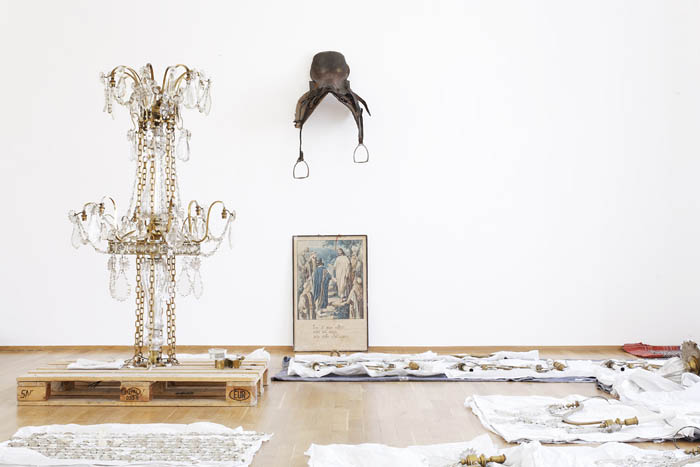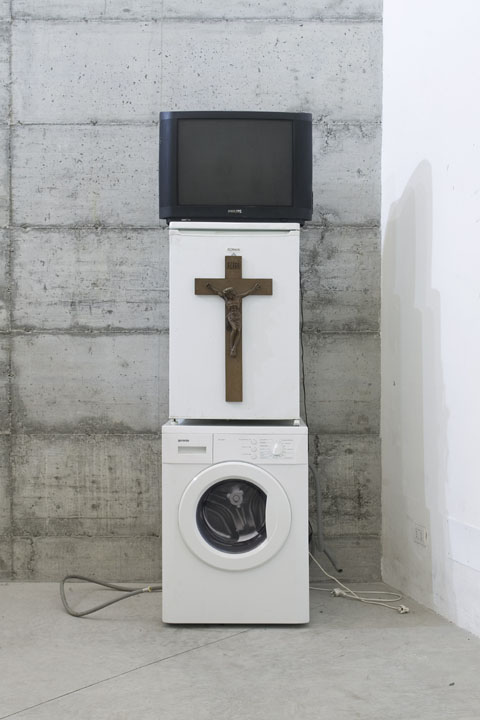DANH VO
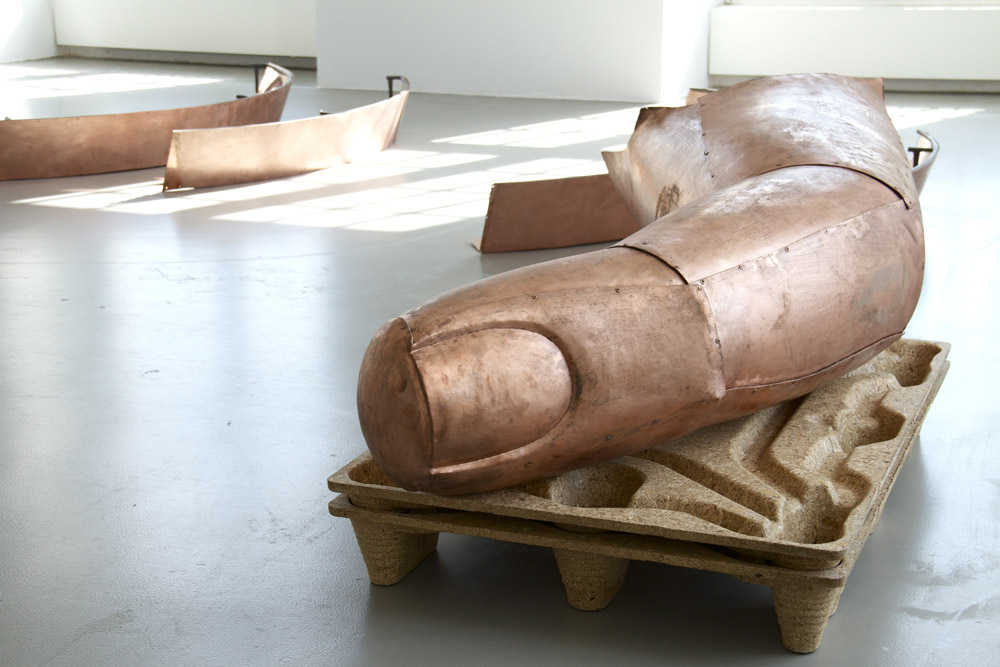
Né en 1975 au Vitenam. Diplômé de de la Royal Academy of Fine Arts de Copenhague et de la Städelschule de Frankfort. Vit et travaille à Berlin.
Born in Vietnam in 1975. Graduated from Royal Academy of Fine Arts, Copenhagen and Städelschule, Frankfurt. Currently lives and works in Berlin.
Dans l’oeuvre de Vo, l’Histoire semble se confondre avec son histoire personnelle, les questions universelles avec ses expériences autobiographiques. Sa recherche s’inscrit dans le registre de la fragilité et de la mutabilité. Elle se manifeste également par un processus d’accumulation intense et d’un collectionnisme méticuleux d’éléments en apparence sans mémoire : des photographies, des souvenirs, des fragments, qui bien entendu ont une force de témoignage. Ses projets portent en grande partie sur la vie privée, les désirs, l’identité, tout en considérant les dynamiques institutionnelles et en approfondissant les questions identitaires et les paradoxes de la société occidentale.
Dans Autoerotic Asphyxiation (2010), par exemple, l’artiste rassemble dans une même salle les photographies de jeunes vietnamiens prises dans les années 60 par le militaire américain Joseph Carrier et la reproduction par son propre père de la lettre qu’un missionnaire français condamné à mort au Vietnam écrit à son père au XIXème siècle. Présentés ensemble, ces éléments questionnent le concept de colonialisme et les modalités avec lesquelles il a influencé, et influence encore, les mémoires collective et individuelle, en portant une attention particulière à la dimension religieuse. Dissimulée par des voiles, la netteté des images est mise en question, créant ainsi un court-circuit entre ce qui est indéniable et ce que nous refusons de percevoir.
Danh Vo est principalement connu pour son oeuvre fragmentée We The People (2010). Il s’agit d’un projet monumental qui tend à réaliser à échelle 1 une copie de la statue de la Liberté, projet que Danh Vo choisit de poursuivre lorsqu’il découvre que la paroi de cette immense statue n’est pas plus épaisse que 3 mm. Puisant dans la force symbolique du monument, Danh Vo décide de produire un certain nombre de pièces – intitulées « We the People (detail) » – qui seront ainsi dispersées dans le monde. L’œuvre est ensuite présentée de façon très libre dans les musées du monde entier.
Les œuvres de Danh Vo sont ainsi imprégnées de force politique. Sans être directes et frontales, elles interrogent les rapports de pouvoir qui sous-tendent les sociétés libérales, les règles qui les régissent et la fragilité de l’idée d’État-nation. Elles révèlent la complexité des échanges entre les peuples dans le contexte de la décolonisation. Le travail de l’artiste se construit autour de la circulation des valeurs, qu’elles soient matérielles, économiques, symboliques ou spirituelles.
Source: CNAP, MAM, Palazzo Grassi
Danh Vo is regarded as one of the most exciting young contemporary artists. At first, however, Danh Vo, who was born in Vietnam and grew up in Denmark, was like a phantom in the art world. In his installations he links aspects of his own adventurous life with excursions into war and colonial history. Danh Vo’s conceptual artworks and installations often draw upon elements of personal lived experience (his own, the lives of his parents and other family members) to explore broader historical, social or political themes, particularly those relating to the history of Vietnam at the close of the twentieth century.
A typical Danh Vo trick: The Danish artist of Vietnamese descent draws connections between the past (which for Vo primarily consists of a colonial and war history) and the present. In the process, he lays tracks that occasionally lead our expectations ad absurdum. This applies to the historical and cultural material he incorporates in his work as well as to his own life. For a long time the artist’s existence was scarcely more than a rumor, and his name was merely a promise, or a joke. Just three years ago, if you searched the Internet for photos from one Danh Vo, you found portraits of an Asian-looking schoolboy with a large pair of glasses. The man, an artist around 30 years old, remained virtually invisible. He invariably left only vague traces – in exhibition spaces or in interviews. If you wanted to read these traces, it seemed, you had to find out more about this person and his life.
With the work Oma-Totem (Grandma Totem) Danh Vo actually exhibited in Switzerland a copy of the tombstone that he had made for his grandmother. The gravestone is a cast of a sculpture composed of a refrigerator on whose door a crucifix is attached, a washing machine and a television. The appliances were gifts from the social welfare office that were given to every refugee upon arrival in Denmark. What arrangement had the woman made before her death? How can a lifeless object do justice to a lived life? « I relate biographies, but in such a way that I undermine the principle of biography, » says the artist.
His origins and his flight from Vietnam are a kind of prehistory. After the Communists’ victory and the fall of Saigon, the Vo family and 20,000 other South Vietnamese were brought in 1975 to the island of Phu Quoc. Following four years during which they struggled to survive, the father built a boat and the family set off to America. But a short time later a freighter belonging to the Danish Maerskshipping company fished out the refugees, and four-year-old Danh Vo become a Dane and not an American.
Danh Vo’s installations often address issues relating to identity and belonging, authorial status, ownership and the role of personal relationships. He is particularly interested in the discrepancies between myth and reality, between the past and the present, and between the identities and histories imposed upon him by others and those that he creates for himself.
Source : Xavier Hufkens gallery, Deutsche Bank
TRAVAUX/WORKS :

Ink drawing and gold leaf on cardboard Budweiser box
40 × 40 × 27 cm | 15 11/16 × 15 11/16 × 10 ⅝ inches
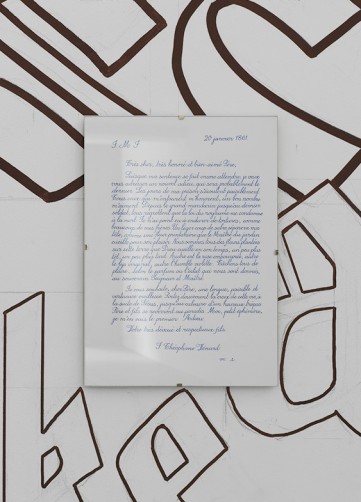
Ink on A4 paper
29,6 × 21 cm | 11 ⅝ × 8 ¼ inches
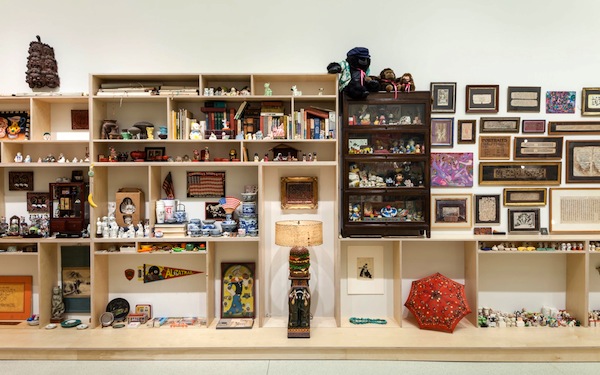



Calligraphy in pencil and ink, wooden figure (crucifix)
265 × 330 × 20 cm | 104 ⅛ × 129 5/16 × 7 5/16 inches
